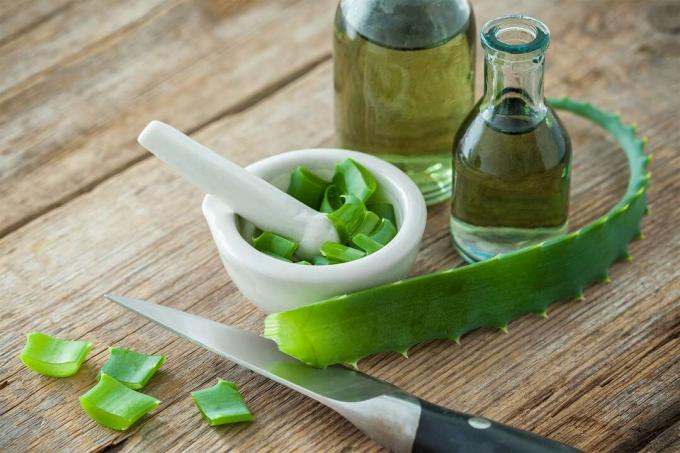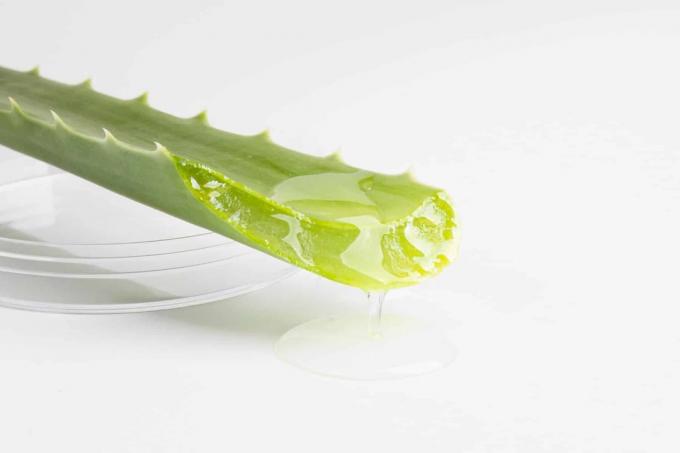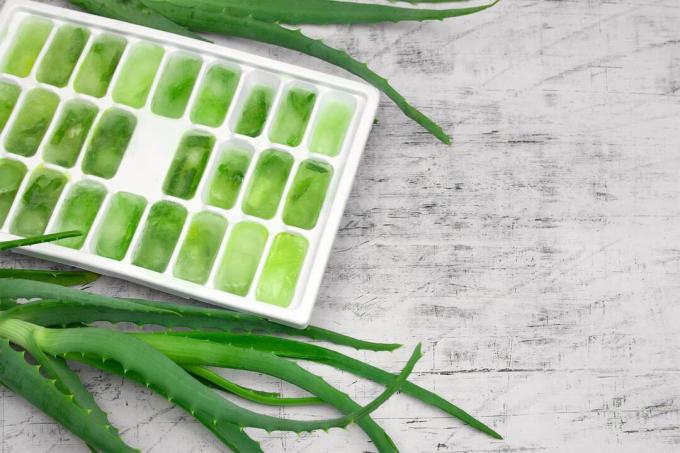
Aloe vera products are considered to be particularly good for skin care. If you want to save the money for expensive care products, you can easily make the gel yourself from the leaves.
In a nutshell
- only harvest leaves that are at least three years old
- store fresh gel for a maximum of two weeks
- preservatives or deep freeze for a longer shelf life
Table of contents
- Utensils needed
- manufacturing
- use
- durability and storage
- frequently asked Questions
Utensils needed

To make aloe vera gel yourself, in addition to the leaves, you need:
- sharp knife
- Spoon
- water glass
- Vegetable peeler (optional)
- screw-top jar
- small bowl (optional)
- Blender/mortar (optional)
A notice: So that the valuable gel is not contaminated, you should disinfect knives & co before use.
manufacturing
harvest leaves

For do-it-yourself aloe vera-Gel you should only harvest leaves that are at least three years old. As they age from the inside out, those on the outer edge of the plant are destined for harvest. Proceed as follows:
- Use the sharp knife to cut the leaf as close to the base as possible
- alternatively: carve and twist off
drain juice
So that the yellowish juice containing aloin can drain off, place the leaf with the cut surface down in the water glass for about an hour. Then cut off about one to two centimeters from the lower end of the leaf. This ensures that there are no juice residues in the leaf.

scrape out gel
Since the gel is inside the leaf,
- peel off the outer layer of leaves with a knife or vegetable peeler or
- halve the sheet lengthwise.
Now you can scrape out the aloe vera gel with the spoon. Hold the leaf over a screw-top jar or small bowl so that nothing is lost.

use
A variety of properties are attributed to aloe vera gel, such as:
- cooling
- calming
- soothing
- moisturizing
- pain relieving
- anti-inflammatory
- cell renewal
Because of these properties the gel of real aloe is considered an all-rounder for the skin. It is said to help with sunburn and insect bites and promote wound healing. Furthermore, aloe vera gel is used for dry and/or damaged hair. Since it moisturizes the scalp, it is said to help against dandruff.
A notice: In the case of hair and/or scalp problems, the effect should best unfold in the form of a hair treatment. Leave the gel on for five minutes and then wash it off. If it gets into your hair overnight, you can simply comb it out the next morning.
durability and storage
Refrigerator
Freshly made aloe vera gel will keep in the refrigerator for about a week or two if stored in a sealed container such as a jar. However, you can extend the shelf life by processing it with a preservative and blender into a homogeneous mass:

- one gram of vitamin C powder (alternatively 10 to 20 drops of tocopherol) per 100 grams of gel (shelf life four to six weeks)
- pure alcohol (95 percent) with a proportion of 15 to 20 percent (shelf life for several months)
freezer
For storage in the freezer, it is advisable to freeze the aloe vera gel in portions. So you can thaw it as needed. Proceed as follows:
- puree gel
- pour into ice cube trays
- deep freeze
- Shelf life: about eight months

A notice: If you don't have time to scrape the gel out of the leaves, cut the drained aloe vera leaves into small pieces and put them in the freezer.
frequently asked Questions
Cut aloe vera leaves should keep for several weeks if you place them vertically (cut side down) in a jar. Nevertheless, you should process the leaves as soon as possible and preserve the harvested gel.
By the time it is three years old, the plant should have at least twelve leaves. You should take care of an aloe with fewer leaves, because it needs a certain number of leaves to cope with the loss of the cut green.
The positive properties of the gel relate to real aloe (Aloe vera). It is often sold commercially under the name Aloe barbadensis.



